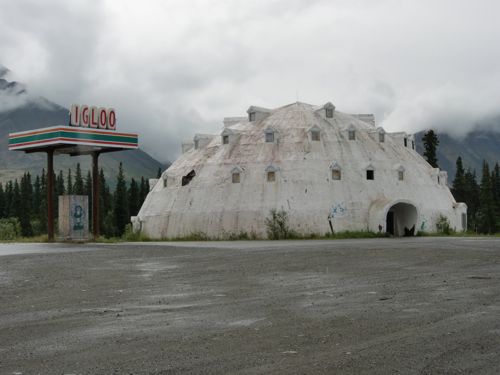What does a PolarTREC teacher do when they have 10 days to fill in Alaska between expeditions? The hardest part of this question is deciding just where to spend those days. I chose to explore South-Central Alaska and headed down to the Kenai Peninsula with my husband to explore the world of glacier and ocean--two environments that are non-existent in Colorado.
 The perfect Alaska view; fireweed, mountains, and snowfields.
The perfect Alaska view; fireweed, mountains, and snowfields.
The trip began with a long drive to Seward, almost 400 miles south of Fairbanks. Seward was named after William H. Seward, who was Lincoln's secretary of State and was responsible for negotiating the purchase of Alaska from Russia in 1867. It is now a major fishing and tourist center, surrounded by spectacular peaks rising from the ocean. It is also a great spot to spend some time hiking and sea kayaking around glaciers. Seward is home to the Kenai Fjords National Park. We were able to spend a day hiking to the Harding Ice Field--an amazing sheet of ice that is the source of the glaciers that are found in the park's many fjords. It's several thousand feet thick and spreads for miles.
 The Harding Ice Field in Kenai Fjords National Park, is thousands of feet thick and feeds 40 glaciers.
The Harding Ice Field in Kenai Fjords National Park, is thousands of feet thick and feeds 40 glaciers.
To fully appreciate the tidal glaciers, we needed to spend time in one of the fjords. We signed up for a guided 2-day sea kayak journey to Aialik Bay and the Aialik Glacier. The trip starts (and ends) with 1 2 1/2 hour trip in a water taxi from Seward to the bay. We kayaked from our campsite to the glacier and were able to watch and listen to enormous chunks of the glacier peel off into the ocean. Aialik glacier is not retreating as fast as some of the other glaciers in that area. Other glaciers in that area have retreated so far in the past 100 years that they no longer reach the ocean. If you want to see paired images of these and other Alaskan glaciers, you should check out this website: http://www.usgs.gov/global_change/glaciers/repeat_photography.asp
 Here's where the Aialik Glacier reaches the sea. We could hear the thunderous roar all night as chunks of glacier calved into the ocean.
Here's where the Aialik Glacier reaches the sea. We could hear the thunderous roar all night as chunks of glacier calved into the ocean.
 This swan-shaped chunk of ice was once part of the glacier!
This swan-shaped chunk of ice was once part of the glacier!
From Seward we headed north, west, and south again to the town of Homer to visit friends there and check out the western side of the Kenai. We were treated to a spectacular flight from a friend who works for a local air service. He took us out for a view of the mountains, glaciers, and ocean.
 Mountains and glaciers all around us as we flew near Homer.
Mountains and glaciers all around us as we flew near Homer.
After a few days in Homer, it was time to head north to Fairbanks. It was raining much of the trip north, so we never got to view Denali. We did, however, get to see a 'real' igloo. There was even a sign. It's for sale--you could buy the igloo and 38 acres of land and have a great roadside attraction.
 This igloo could be yours--it's for sale!!
This igloo could be yours--it's for sale!!
Today was dedicated to unpacking and repacking for the next expedition. Tomorrow morning I head north again, to the Kivalina River and Raven's Bluff to learn about the science of archaeology. There was just enough time today to head over to Pioneer Park to check out some of the exhibits there about the gold mining days in Fairbanks. It looked a lot different than I remembered it from our visit to the Ice Carving Championships last February. Best of all was the miniature golf--the northernmost miniature golf course in the world (or at least in the United States)!
 Miniature golf, Alaska-style.
Miniature golf, Alaska-style.
 This golf course also had a great garden. I had to take a break and munch on some of the fresh kale and radishes at the 18th hole!
This golf course also had a great garden. I had to take a break and munch on some of the fresh kale and radishes at the 18th hole!
